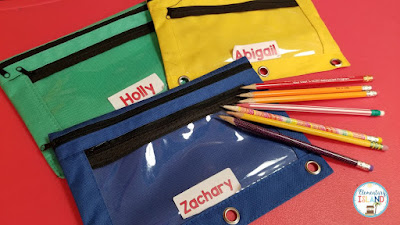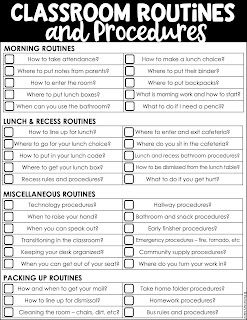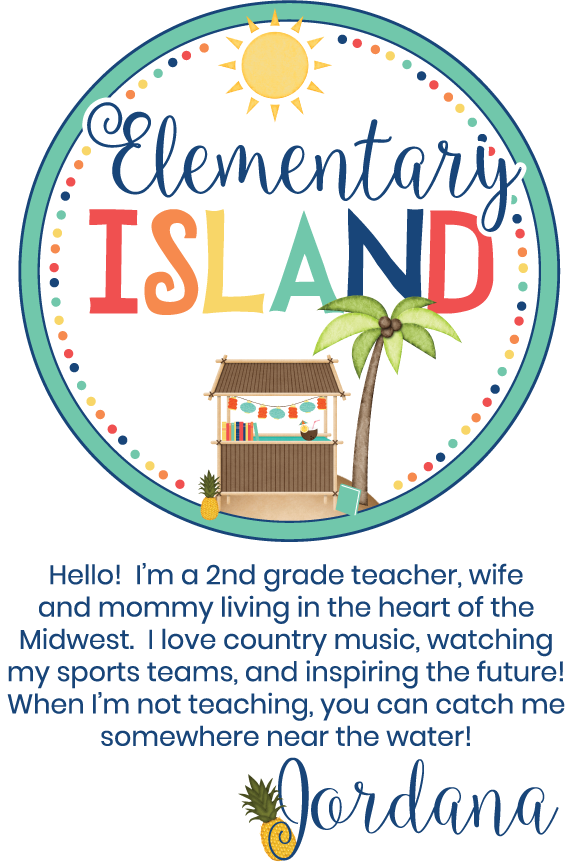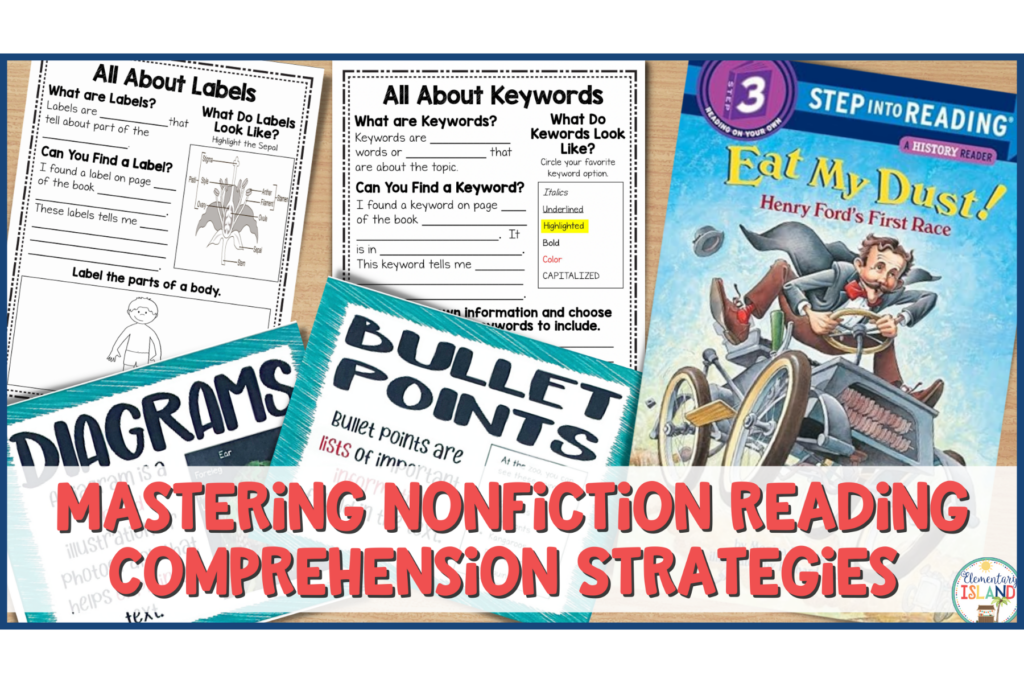34 Important Procedures and Routines for a Successful Elementary Classroom
The first week back to school is so exciting! You are looking forward to getting your classroom ready and seeing those smiling faces that you’ve missed all summer. And while it may be tempting to dive into the curriculum that first week, it is so important to set up and teach your classroom procedures to your students! Elementary procedures and routines are the keys to a well-behaved and structured classroom. Not having these in place will make teaching the curriculum so much harder if you don’t have a well-managed classroom FIRST.

I know that back to school is such a busy time for us as teachers and there are about a million things you are trying to get ready and prepare for. That’s why I have compiled this list of elementary procedures and routines you must do for your classroom to make it a little easier for you. This checklist will help you make sure there is a procedure set in place for each of these concerns. Because we as teachers know that they will come up! Whether you are a new teacher or a veteran looking to strengthen your system, this list is for you.
Plan for these important Procedures and Routines
1. When should students use the restroom?
When will you allow students to use the restroom? During instruction? During independent work only? As a group? What will this look like? Should students raise their hands and ask? Will you have a bathroom pass system? How many students can go at a time? These are all things that need to be considered because this can take up a lot of instructional time in an elementary classroom.
2. What should a student do if he/she has a question?
Students will need to know what to do if they have a question. Is there a certain time that you will allow questions during whole group? What about during or after instruction? How will students show they have a question or need help during independent practice? Is there a signal such as a flipped card on their desk? Do they raise their hand? Can they come to your desk if you’re sitting?
3. What do students do when they are done with their work?
Are there certain activities after language arts vs. after math? Which activities are they? Where do they find these activities? What should their voice level be? Can they do them with a partner or only on their own? Students finish up their work at different times so it is imperative to have a procedure in place to help with behavior.
This is hanging up in my classroom. I go over it at the beginning of every year. We start with the bottom portion blank. The top says, “I’m Done! Now What?” Then it goes on to say, “Always, always, always, always …. do LATE WORK!” The bottom portion says, “And Then….” So when they have finished the current assignment and late work (if they had any) then they can choose an activity from the bottom.
This list builds throughout the year when new programs and activities are introduced. As you can see, I have AR, Boom Cards, IXL, Study Island, Find AR books, etc… This way students will ALWAYS have something to work on. There will be no excuse for off-task behavior and they are given guided choice.
4. Conversly, what will students do if they are not done with their work when you need to move on?
Where do students put their late work? When will they have time to work on this work? I have found that most students will just shove their late work into their desk to never be seen again. Instead, I have had my students put their work in their late work bins. These are numbered by student numbers so that they can be used year to year.
5. Where do students turn in their work?
Do they keep it at their desk? Turn it in as they finish? Will you call them up to turn them in together? Will you separate assignments or collect them in number order?
6. What to do if a student is absent?
Do they get work before or after they are absent? Is there a folder where they will find this work? Will you do it or put a student in charge of it? When will the work be due?
7. What hallway procedures will you have?
8. How will you get students’ attention?
Will you have certain callbacks? When will you practice? You will need to fit in practice often during the beginning of the school year. Pick up these
attention grabbers that will get you started on your list!
9. How will you have students line up?
Will they line up in two lines? Number order? Boys and girls? Will there be spots around the classroom? No order? What will the expectations be as they are waiting in line? Thinking of these things before the students are in the classroom will help with inappropriate behavior.
10. What will your end-of-the-day procedures look like?
Will you dismiss by girls? Boys? Rows? Numbers? When they are dismissed, what will they get? Will they pick up their mail? Stack their chairs? Get their backpacks? Will you check their binders before they leave?
11. How will students enter the classroom in the morning?
Will they make a lunch choice? What do they do for attendance? Do they have something they need to get started on like bellwork? Is it on their desk or do they need to go and get it somewhere? I always had this on the projector in the morning when my students came in as a reminder of what they needed to do.
12. How will you convey your routine for a substitute?
Will you have a sub folder? Sub tub? What will you include in your folder?
13. What should students do if they need a new pencil?
You wouldn’t think this would be that big of a problem, but trust me, it IS! The can be a huge distraction the entire day. Pencils break every .10 of a second in a classroom – that’s a lot of raised hands! Can they sharpen their pencil? Is there a place to turn in their pencil for a new one? Do you use pencil pouches? (let me tell you, THIS is the answer!) Click to learn more about how I use
PENCIL POUCHES in the classroom.14. Where should students line up after recess and lunch?
Where should they expect to meet you? What should their line behavior look like? Will you have a call back?
15. What will the procedures be for taking a test?
Do all regular rules apply still? Can they get out of their seat at all? Do they need blinders or should they cover their paper? What happens if they have a question? What if they talk to a neighbor? What do students do when they finish a test? Should they get up to turn it in or will that distract others and cause students to rush?
16. What are your classroom rules?
This is an entire subject unto itself 😉 Think carefully about these. Will you introduce them to the students or will you make them up together? Will you implement them on the first day? Where can students find the rules? It doesn’t matter what they look like, just make sure they are posted and reviewed by the minute.
17. What is your classroom behavior plan?
18. What are your classroom jobs?
These are very important. Not only are students truly excited to be helping out the teacher, but they really ARE helping the teacher out. If you can delegate the job, do it! Think of jobs that you may have to start the year off with and possibly some other jobs that can be added throughout the year as students get comfortable with the routine. I like to try to match my jobs to my theme!
19. What are the classroom library procedures?
How are your books organized? Do they put the book back where they got it from or is this a student job? How do they know what books to pick? How many books are they able to pick? Can they pick their books at any time during the day or only during reading time? Can they read with a partner?
20. How should students sit on the carpet for learning?
I love to use sit spots! You can find them in most educational stores now and online.
21. What if a student is going to get sick in your classroom?
22. How and where do students get the materials they need?
Will all their materials be kept at their desk or will you collect some for communal use?
23. What are the expectations for independent work?
Can students get out of their seat? What do they do if they have a question? How should students be working? Do you allow students to stand who have wiggles or must they remain in their seat? Do you allow flexible seating options? How do you decide who sits in the flexible seating areas? What are the rules for talking to peers?
24. Where should students put their backpacks?
Do they keep them at their desk? Is there a place to hang them (please say yes)? Are they allowed to visit their backpacks?
25. What is your homework policy?
Will students have homework? If so, what are they expected to do? When does the work go home and when is it expected to be completed by? Where do students turn in their work? Can they turn it in early? Will you be differentiating work?
26. When can students get a tissue?
Again, seems fairly minor in the grand scheme of things, but in the elementary classroom you would be wrong. Can this be done at any time? Is there a hand signal to use? How many are they able to use at once? Where do they discard of the tissue when they have used it?
27. What is appropriate playground/recess behavior?
Are students allowed to play tag or dodgeball? Are they able to bring toys from home? What do they do if they have nobody to play with? What if they get hurt, what should they do? What are the rules if there is snow on the ground? Do they need snow pants? What happens if it is raining? Where would they go for recess? What are those rules?
28. What are the procedures for fire, tornado and other drills?
29. When can students get a drink?
Are they able to go at any point in the day? Only before and after recess or specials? Are they able to bring water bottles?
30. What technology procedures will you have in place?
Can students use tech when they finished all their work? Will you have way to monitor them on the ipad?
31. What are the expectations for group work and partner work?
Do they all turn in the same assignment? Are students given different jobs during their collaborative work? How do you know they all participated?
32. What are the expectations for students to keep their desks and areas clean?
33. What if a student needs to work with another teacher?
Will the student be expected to make up the work they are leaving behind?
34. Will you allow a snack time in class?
I hope this list will help you plan out your elementary procedures and routines so that you will have a successful start to your school year! This definitely is not an exhaustive list, but it’s enough to get you started. Nothing, and I mean nothing, is too small to think about and have a plan for.
Save these ideas to your favorite classroom Pinterest board so you can come back or share out to your favorite teacher friend! I’d love to hear what you are setting up for the beginning of the year. Comment below!


























